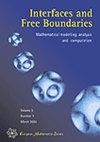d维N时钟模型的粗粒度和大N行为
IF 1
4区 数学
Q1 MATHEMATICS
引用次数: 7
摘要
我们研究了$N$ -时钟模型的渐近行为,这是一个在$d$维立方$\varepsilon$ -晶格上的最近邻铁磁自旋模型,其中自旋场被约束为在由$N$等距点组成的单位圆$\mathbb{S}^{1}$的离散化$\mathcal{S}_N$中取值。我们的$\Gamma$ -收敛分析包括两个步骤:首先,我们固定$N$并让晶格间距$\varepsilon \to 0$,得到在分段恒定自旋场上定义的连续统中的界面能量,其值为$\mathcal{S}_N$;在第二阶段,我们让$N \to +\infty$。这两步极限过程的最终结果是有界变化的$\mathbb{S}^1$值向量场的各向异性总变分。本文章由计算机程序翻译,如有差异,请以英文原文为准。
Coarse graining and large-$N$ behavior of the $d$-dimensional $N$-clock model
We study the asymptotic behavior of the $N$-clock model, a nearest neighbors ferromagnetic spin model on the $d$-dimensional cubic $\varepsilon$-lattice in which the spin field is constrained to take values in a discretization $\mathcal{S}_N$ of the unit circle~$\mathbb{S}^{1}$ consisting of $N$ equispaced points. Our $\Gamma$-convergence analysis consists of two steps: we first fix $N$ and let the lattice spacing $\varepsilon \to 0$, obtaining an interface energy in the continuum defined on piecewise constant spin fields with values in $\mathcal{S}_N$; at a second stage, we let $N \to +\infty$. The final result of this two-step limit process is an anisotropic total variation of $\mathbb{S}^1$-valued vector fields of bounded variation.
求助全文
通过发布文献求助,成功后即可免费获取论文全文。
去求助
来源期刊
CiteScore
1.70
自引率
0.00%
发文量
17
审稿时长
>12 weeks
期刊介绍:
Interfaces and Free Boundaries is dedicated to the mathematical modelling, analysis and computation of interfaces and free boundary problems in all areas where such phenomena are pertinent. The journal aims to be a forum where mathematical analysis, partial differential equations, modelling, scientific computing and the various applications which involve mathematical modelling meet. Submissions should, ideally, emphasize the combination of theory and application.

 求助内容:
求助内容: 应助结果提醒方式:
应助结果提醒方式:


